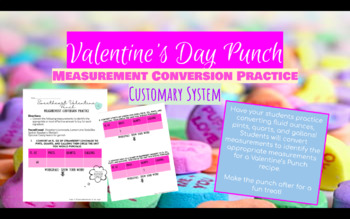Valentine's Day Punch Measurement (Math)Conversion Activity- 4th, 5th, 6th Grade
- PDF
Description
I found this Valentine's Day punch recipe from @Jenaroundtheworld.com
Here is the link to her site with the actual recipe and directions if you would like to visit:
https://jenaroundtheworld.com/sweetheart-valentine-punch/
I created this activity for my 5th grade class. They are currently learning how to convert measurements, specifically capacity, within the customary system of measurement. With Valentine's Day around the corner, I wanted to integrate a real-world activity and decided on a Valentine's punch.
Students will practice converting fluid ounces, pints, quarts, and gallons. For each ingredient there is a measurement given. Students will then convert each measurement to the other units. Students will then identify the appropriate size they would buy to make the punch. For example, if I needed 2 pints of soda, it would make the most sense to buy 1 quart instead.
Have fun making this punch with your class after! You will need strawberry lemonade, lemon-lime soda, and raspberry sherbert. I plant to top ours with candy hearts.
- 64 ounces strawberry lemonade (Simply Lemonade brand will work)
- 1 liter of lemon-lime soda like Sprite
- 1 pint of raspberry sherbert
Cheers!
-Hillary





